Library Science Report on Tribal and Non-Tribal Groups
VerifiedAdded on 2022/10/05
|5
|1130
|204
Report
AI Summary
This report explores the collaborations between tribal and non-tribal organizations, emphasizing knowledge sharing and cultural resources within library science. It examines the impact of these collaborations, highlighting the importance of addressing past misinterpretations and fostering understanding. The report discusses key findings from a national survey, addressing issues in indigenous archives, museums, and libraries. It also delves into the challenges of digital archives, including the preservation of writers' digital files. Furthermore, the report analyzes the processes of appraisal and arrangement of archival records, including the application of functional and institutional records. The study emphasizes the significance of partnerships and provides insights into best practices for tribal and non-tribal organizations aiming to share expertise, knowledge, and cultural resources.
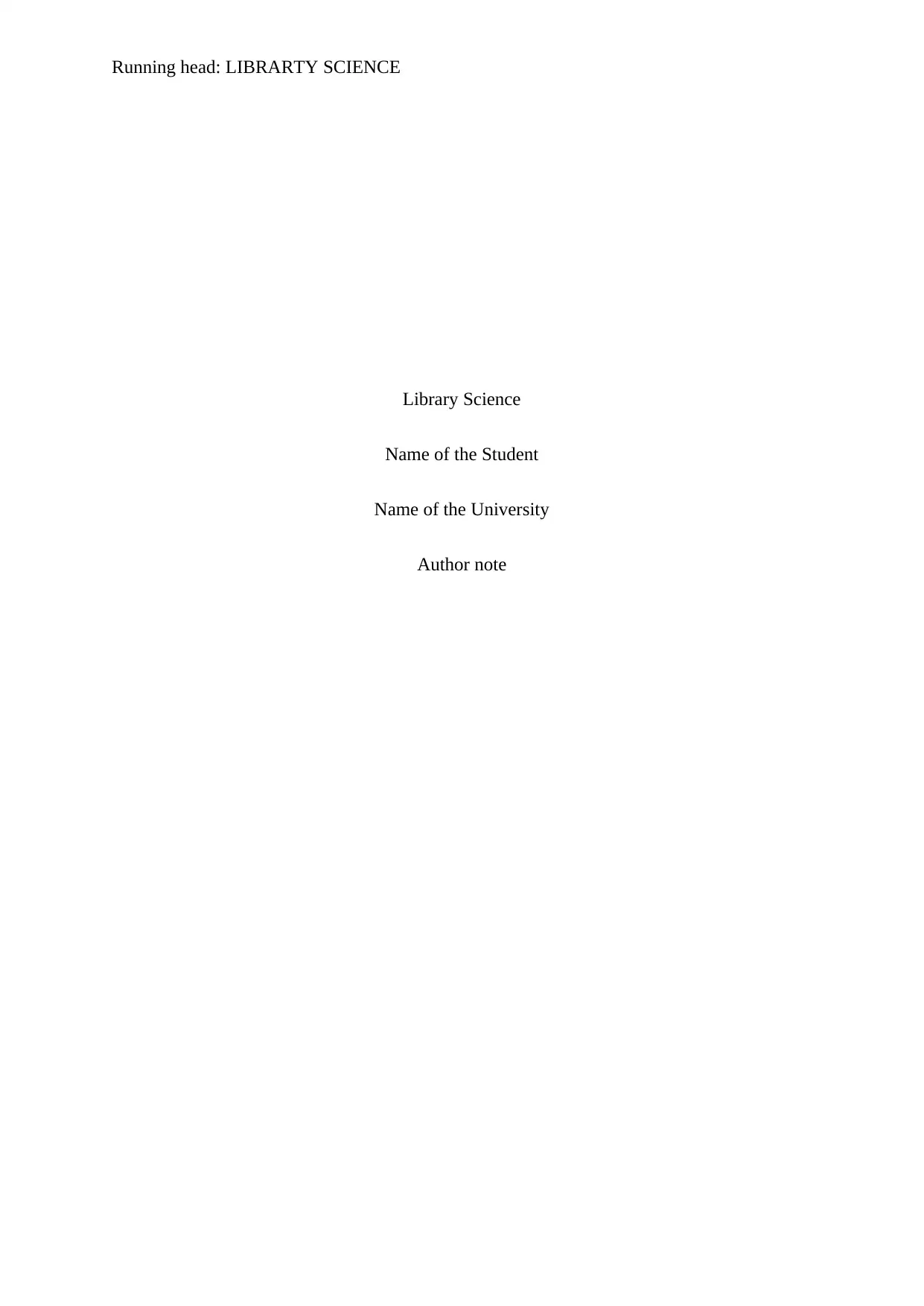
Running head: LIBRARTY SCIENCE
Library Science
Name of the Student
Name of the University
Author note
Library Science
Name of the Student
Name of the University
Author note
Paraphrase This Document
Need a fresh take? Get an instant paraphrase of this document with our AI Paraphraser
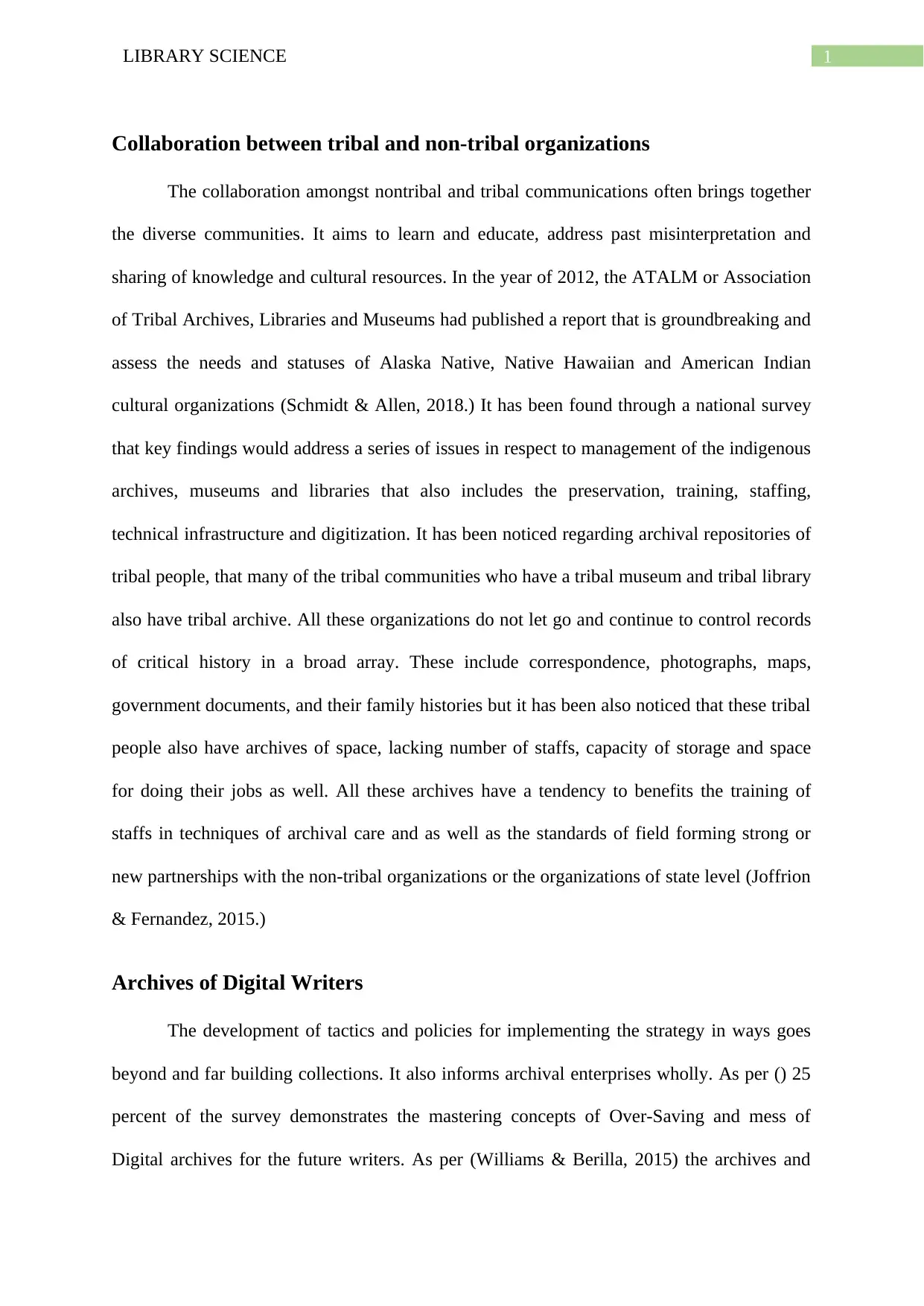
1LIBRARY SCIENCE
Collaboration between tribal and non-tribal organizations
The collaboration amongst nontribal and tribal communications often brings together
the diverse communities. It aims to learn and educate, address past misinterpretation and
sharing of knowledge and cultural resources. In the year of 2012, the ATALM or Association
of Tribal Archives, Libraries and Museums had published a report that is groundbreaking and
assess the needs and statuses of Alaska Native, Native Hawaiian and American Indian
cultural organizations (Schmidt & Allen, 2018.) It has been found through a national survey
that key findings would address a series of issues in respect to management of the indigenous
archives, museums and libraries that also includes the preservation, training, staffing,
technical infrastructure and digitization. It has been noticed regarding archival repositories of
tribal people, that many of the tribal communities who have a tribal museum and tribal library
also have tribal archive. All these organizations do not let go and continue to control records
of critical history in a broad array. These include correspondence, photographs, maps,
government documents, and their family histories but it has been also noticed that these tribal
people also have archives of space, lacking number of staffs, capacity of storage and space
for doing their jobs as well. All these archives have a tendency to benefits the training of
staffs in techniques of archival care and as well as the standards of field forming strong or
new partnerships with the non-tribal organizations or the organizations of state level (Joffrion
& Fernandez, 2015.)
Archives of Digital Writers
The development of tactics and policies for implementing the strategy in ways goes
beyond and far building collections. It also informs archival enterprises wholly. As per () 25
percent of the survey demonstrates the mastering concepts of Over-Saving and mess of
Digital archives for the future writers. As per (Williams & Berilla, 2015) the archives and
Collaboration between tribal and non-tribal organizations
The collaboration amongst nontribal and tribal communications often brings together
the diverse communities. It aims to learn and educate, address past misinterpretation and
sharing of knowledge and cultural resources. In the year of 2012, the ATALM or Association
of Tribal Archives, Libraries and Museums had published a report that is groundbreaking and
assess the needs and statuses of Alaska Native, Native Hawaiian and American Indian
cultural organizations (Schmidt & Allen, 2018.) It has been found through a national survey
that key findings would address a series of issues in respect to management of the indigenous
archives, museums and libraries that also includes the preservation, training, staffing,
technical infrastructure and digitization. It has been noticed regarding archival repositories of
tribal people, that many of the tribal communities who have a tribal museum and tribal library
also have tribal archive. All these organizations do not let go and continue to control records
of critical history in a broad array. These include correspondence, photographs, maps,
government documents, and their family histories but it has been also noticed that these tribal
people also have archives of space, lacking number of staffs, capacity of storage and space
for doing their jobs as well. All these archives have a tendency to benefits the training of
staffs in techniques of archival care and as well as the standards of field forming strong or
new partnerships with the non-tribal organizations or the organizations of state level (Joffrion
& Fernandez, 2015.)
Archives of Digital Writers
The development of tactics and policies for implementing the strategy in ways goes
beyond and far building collections. It also informs archival enterprises wholly. As per () 25
percent of the survey demonstrates the mastering concepts of Over-Saving and mess of
Digital archives for the future writers. As per (Williams & Berilla, 2015) the archives and
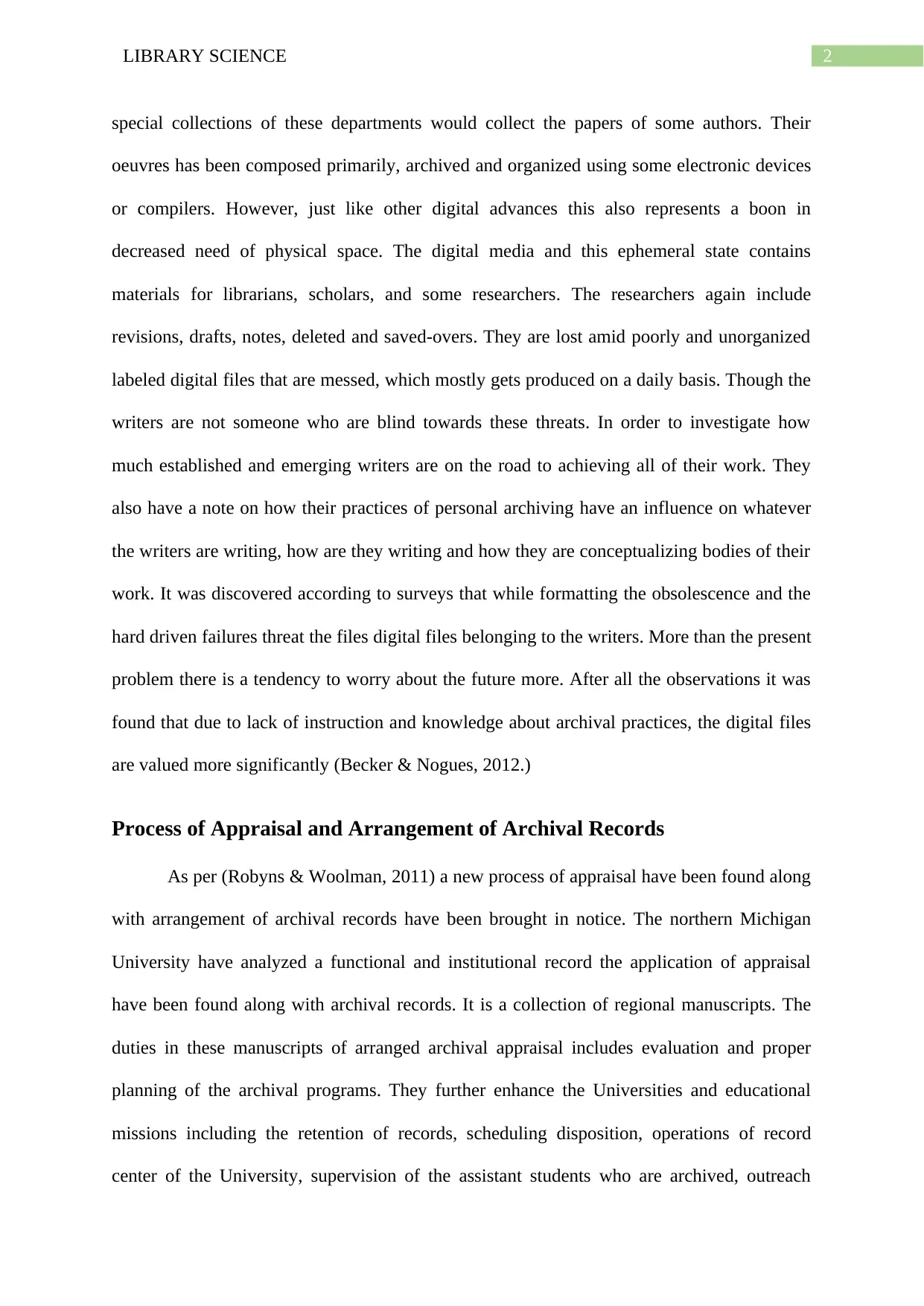
2LIBRARY SCIENCE
special collections of these departments would collect the papers of some authors. Their
oeuvres has been composed primarily, archived and organized using some electronic devices
or compilers. However, just like other digital advances this also represents a boon in
decreased need of physical space. The digital media and this ephemeral state contains
materials for librarians, scholars, and some researchers. The researchers again include
revisions, drafts, notes, deleted and saved-overs. They are lost amid poorly and unorganized
labeled digital files that are messed, which mostly gets produced on a daily basis. Though the
writers are not someone who are blind towards these threats. In order to investigate how
much established and emerging writers are on the road to achieving all of their work. They
also have a note on how their practices of personal archiving have an influence on whatever
the writers are writing, how are they writing and how they are conceptualizing bodies of their
work. It was discovered according to surveys that while formatting the obsolescence and the
hard driven failures threat the files digital files belonging to the writers. More than the present
problem there is a tendency to worry about the future more. After all the observations it was
found that due to lack of instruction and knowledge about archival practices, the digital files
are valued more significantly (Becker & Nogues, 2012.)
Process of Appraisal and Arrangement of Archival Records
As per (Robyns & Woolman, 2011) a new process of appraisal have been found along
with arrangement of archival records have been brought in notice. The northern Michigan
University have analyzed a functional and institutional record the application of appraisal
have been found along with archival records. It is a collection of regional manuscripts. The
duties in these manuscripts of arranged archival appraisal includes evaluation and proper
planning of the archival programs. They further enhance the Universities and educational
missions including the retention of records, scheduling disposition, operations of record
center of the University, supervision of the assistant students who are archived, outreach
special collections of these departments would collect the papers of some authors. Their
oeuvres has been composed primarily, archived and organized using some electronic devices
or compilers. However, just like other digital advances this also represents a boon in
decreased need of physical space. The digital media and this ephemeral state contains
materials for librarians, scholars, and some researchers. The researchers again include
revisions, drafts, notes, deleted and saved-overs. They are lost amid poorly and unorganized
labeled digital files that are messed, which mostly gets produced on a daily basis. Though the
writers are not someone who are blind towards these threats. In order to investigate how
much established and emerging writers are on the road to achieving all of their work. They
also have a note on how their practices of personal archiving have an influence on whatever
the writers are writing, how are they writing and how they are conceptualizing bodies of their
work. It was discovered according to surveys that while formatting the obsolescence and the
hard driven failures threat the files digital files belonging to the writers. More than the present
problem there is a tendency to worry about the future more. After all the observations it was
found that due to lack of instruction and knowledge about archival practices, the digital files
are valued more significantly (Becker & Nogues, 2012.)
Process of Appraisal and Arrangement of Archival Records
As per (Robyns & Woolman, 2011) a new process of appraisal have been found along
with arrangement of archival records have been brought in notice. The northern Michigan
University have analyzed a functional and institutional record the application of appraisal
have been found along with archival records. It is a collection of regional manuscripts. The
duties in these manuscripts of arranged archival appraisal includes evaluation and proper
planning of the archival programs. They further enhance the Universities and educational
missions including the retention of records, scheduling disposition, operations of record
center of the University, supervision of the assistant students who are archived, outreach
⊘ This is a preview!⊘
Do you want full access?
Subscribe today to unlock all pages.

Trusted by 1+ million students worldwide
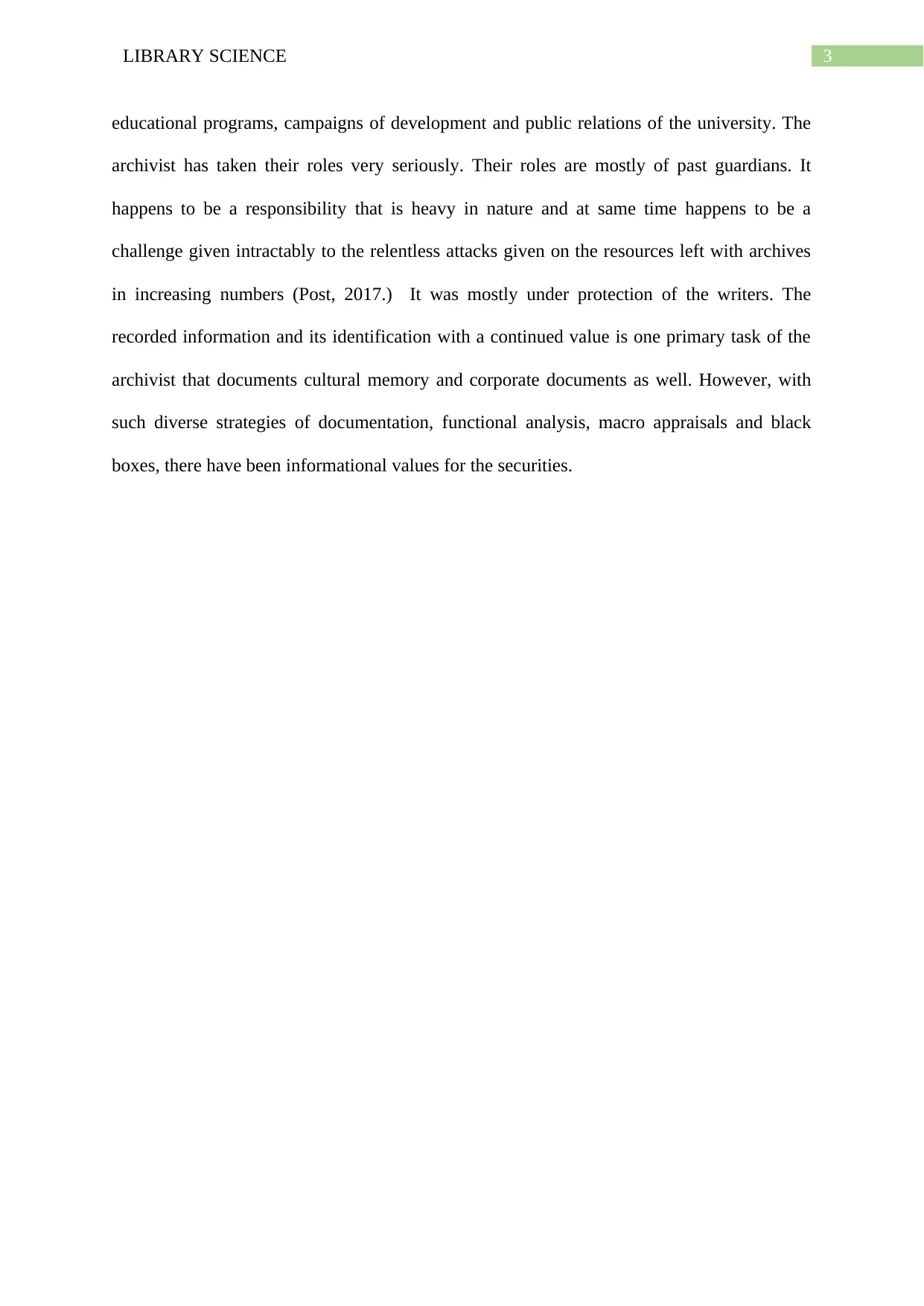
3LIBRARY SCIENCE
educational programs, campaigns of development and public relations of the university. The
archivist has taken their roles very seriously. Their roles are mostly of past guardians. It
happens to be a responsibility that is heavy in nature and at same time happens to be a
challenge given intractably to the relentless attacks given on the resources left with archives
in increasing numbers (Post, 2017.) It was mostly under protection of the writers. The
recorded information and its identification with a continued value is one primary task of the
archivist that documents cultural memory and corporate documents as well. However, with
such diverse strategies of documentation, functional analysis, macro appraisals and black
boxes, there have been informational values for the securities.
educational programs, campaigns of development and public relations of the university. The
archivist has taken their roles very seriously. Their roles are mostly of past guardians. It
happens to be a responsibility that is heavy in nature and at same time happens to be a
challenge given intractably to the relentless attacks given on the resources left with archives
in increasing numbers (Post, 2017.) It was mostly under protection of the writers. The
recorded information and its identification with a continued value is one primary task of the
archivist that documents cultural memory and corporate documents as well. However, with
such diverse strategies of documentation, functional analysis, macro appraisals and black
boxes, there have been informational values for the securities.
Paraphrase This Document
Need a fresh take? Get an instant paraphrase of this document with our AI Paraphraser
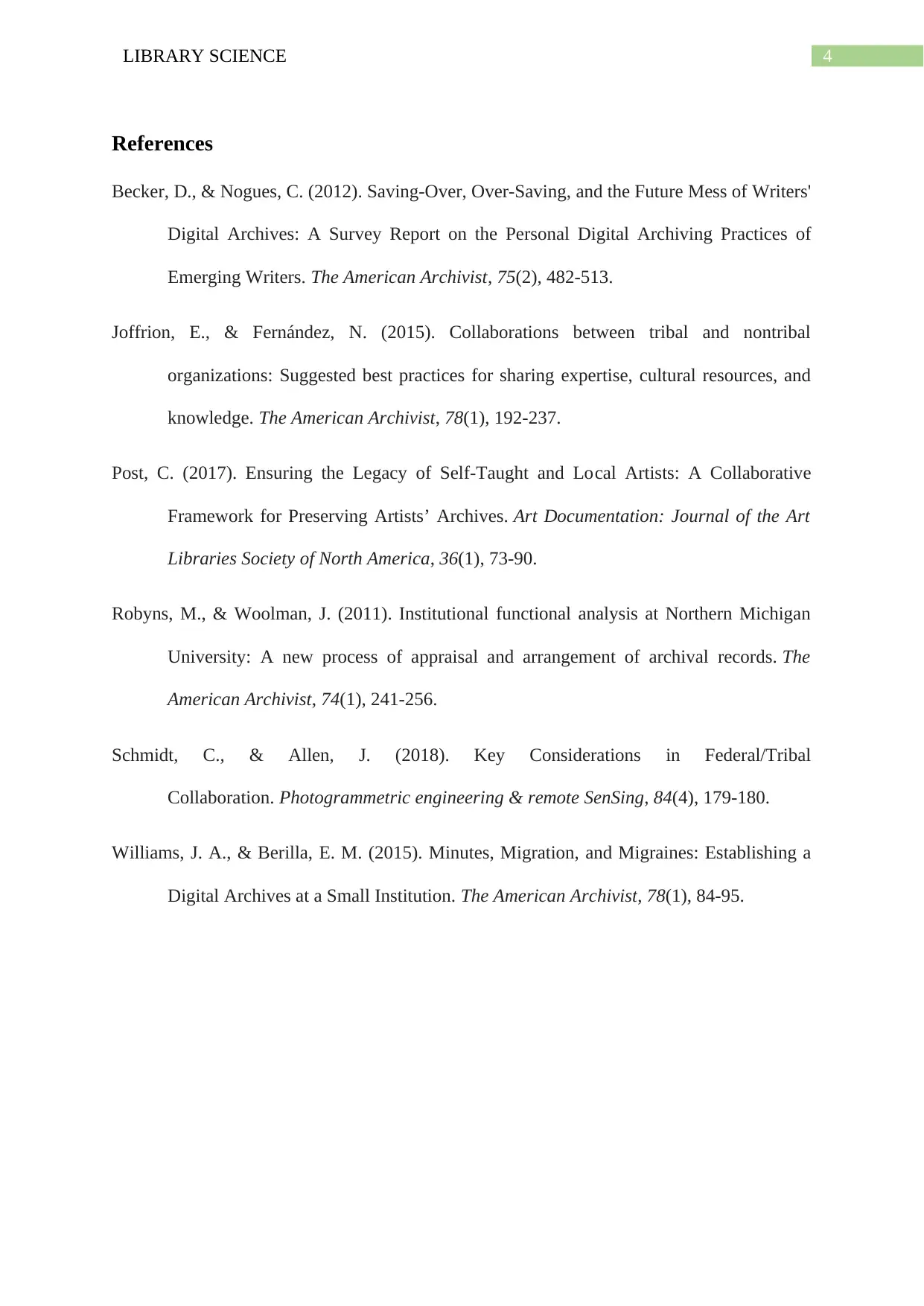
4LIBRARY SCIENCE
References
Becker, D., & Nogues, C. (2012). Saving-Over, Over-Saving, and the Future Mess of Writers'
Digital Archives: A Survey Report on the Personal Digital Archiving Practices of
Emerging Writers. The American Archivist, 75(2), 482-513.
Joffrion, E., & Fernández, N. (2015). Collaborations between tribal and nontribal
organizations: Suggested best practices for sharing expertise, cultural resources, and
knowledge. The American Archivist, 78(1), 192-237.
Post, C. (2017). Ensuring the Legacy of Self-Taught and Local Artists: A Collaborative
Framework for Preserving Artists’ Archives. Art Documentation: Journal of the Art
Libraries Society of North America, 36(1), 73-90.
Robyns, M., & Woolman, J. (2011). Institutional functional analysis at Northern Michigan
University: A new process of appraisal and arrangement of archival records. The
American Archivist, 74(1), 241-256.
Schmidt, C., & Allen, J. (2018). Key Considerations in Federal/Tribal
Collaboration. Photogrammetric engineering & remote SenSing, 84(4), 179-180.
Williams, J. A., & Berilla, E. M. (2015). Minutes, Migration, and Migraines: Establishing a
Digital Archives at a Small Institution. The American Archivist, 78(1), 84-95.
References
Becker, D., & Nogues, C. (2012). Saving-Over, Over-Saving, and the Future Mess of Writers'
Digital Archives: A Survey Report on the Personal Digital Archiving Practices of
Emerging Writers. The American Archivist, 75(2), 482-513.
Joffrion, E., & Fernández, N. (2015). Collaborations between tribal and nontribal
organizations: Suggested best practices for sharing expertise, cultural resources, and
knowledge. The American Archivist, 78(1), 192-237.
Post, C. (2017). Ensuring the Legacy of Self-Taught and Local Artists: A Collaborative
Framework for Preserving Artists’ Archives. Art Documentation: Journal of the Art
Libraries Society of North America, 36(1), 73-90.
Robyns, M., & Woolman, J. (2011). Institutional functional analysis at Northern Michigan
University: A new process of appraisal and arrangement of archival records. The
American Archivist, 74(1), 241-256.
Schmidt, C., & Allen, J. (2018). Key Considerations in Federal/Tribal
Collaboration. Photogrammetric engineering & remote SenSing, 84(4), 179-180.
Williams, J. A., & Berilla, E. M. (2015). Minutes, Migration, and Migraines: Establishing a
Digital Archives at a Small Institution. The American Archivist, 78(1), 84-95.
1 out of 5
Your All-in-One AI-Powered Toolkit for Academic Success.
+13062052269
info@desklib.com
Available 24*7 on WhatsApp / Email
![[object Object]](/_next/static/media/star-bottom.7253800d.svg)
Unlock your academic potential
Copyright © 2020–2025 A2Z Services. All Rights Reserved. Developed and managed by ZUCOL.

